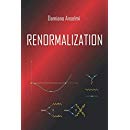Papers
Here are all papers published on Renormalization.COM
A more compact single-page list can be found at this link
We derive the predictions of quantum gravity with fakeons on the amplitudes and spectral indices of the scalar and tensor fluctuations in inflationary cosmology. The action is $R+R^{2}$ plus the Weyl-squared term. The ghost is eliminated by turning it into a fakeon, that is to say a purely virtual particle. We work to the next-to-leading order of the expansion around the de Sitter background. The consistency of the approach puts a lower bound ($m_{\chi }>m_{\phi }/4$) on the mass $m_{\chi }$ of the fakeon with respect to the mass $m_{\phi }$ of the inflaton. The tensor-to-scalar ratio $r$ is predicted within less than an order of magnitude ($4/3 < N^{2}r<12$ to the leading order in the number of $e$-foldings $N$). Moreover, the relation $r\simeq -8n_{T}$ is not affected by the Weyl-squared term. No vector and no other scalar/tensor degree of freedom is present.
J. High Energy Phys. 07 (2020) 211 | DOI: 10.1007/JHEP07(2020)211
The search for purely virtual quanta has attracted interest in the past. We consider various proposals and compare them to the concept of fake particle, or “fakeon”. In particular, the Feynman-Wheeler propagator, which amounts to using the Cauchy principal value inside Feynman diagrams, violates renormalizability, unitarity and stability, due to the coexistence of the prescriptions $\pm i\epsilon $. We contrast the Feynman, fakeon and Feynman-Wheeler prescriptions in ordinary as well as cut diagrams. The fakeon does not have the problems of the Feynman-Wheeler propagator and emerges as the correct concept of purely virtual quantum. It allows us to make sense of quantum gravity at the fundamental level, and places it on an equal footing with the standard model. The resulting theory of quantum gravity is perturbative up to an incredibly high energy.
J. High Energ. Phys. 03 (2020) 142 | DOI: 10.1007/JHEP03(2020)142
The concept of fake particle, or “fakeon”, allows us to make sense of quantum gravity as an ultraviolet complete theory, by renouncing causality at very small distances. We investigate whether the violation of microcausality can be amplified or detected in the most common settings. We show that it is actually short range for all practical purposes. Due to our experimental limitations, the violation does not propagate along the light cones or by means of gravitational waves. In some cases, the universe even conspires to make the effect disappear. For example, the positivity of the Hubble constant appears to be responsible for the direction of time in the early universe.
Class. Quantum Grav. 37 (2020) 095003 | DOI: 10.1088/1361-6382/ab78d2
We give a simple proof of perturbative unitarity in gauge theories and quantum gravity using a special gauge that allows us to separate the physical poles of the free propagators, which are quantized by means of the Feynman prescription, from the poles that belong to the gauge-trivial sector, which are quantized by means of the fakeon prescription. The proof applies to renormalizable theories, including the ultraviolet complete theory of quantum gravity with fakeons formulated recently, as well as low-energy (nonrenormalizable) theories. We clarify a number of subtleties related to the study of scattering processes in the presence of a cosmological constant $\Lambda$. The scattering amplitudes, defined by expanding the metric around flat space, obey the optical theorem up to corrections due to $\Lambda$, which are negligible for all practical purposes. Problems of interpretation would arise if such corrections became important. In passing, we obtain local, unitary (and “almost” renormalizable) theories of massive gravitons and gauge fields, which violate gauge invariance and general covariance explicitly.
J. High Energy Phys. 12 (2019) 027 | DOI: 10.1007/JHEP12(2019)027
Under certain assumptions, it is possible to make sense of higher derivative theories by quantizing the unwanted degrees of freedom as fakeons, which are later projected away. Then the true classical limit is obtained by classicizing the quantum theory. Since quantum field theory is formulated perturbatively, the classicization is also perturbative. After deriving a number of properties in a general setting, we consider the theory of quantum gravity that emerges from the fakeon idea and study its classicization, focusing on the FLRW metric. We point out cases where the fakeon projection can be handled exactly, which include radiation, the vacuum energy density and the combination of the two, and cases where it cannot, which include dust. Generically, the classical limit shares many features with the quantum theory it comes from, including the impossibility to write down complete, “exact” field equations, to the extent that asymptotic series and nonperturbative effects come into play.
J. High Energy Phys. 04 (2019) 61 | DOI: 10.1007/JHEP04(2019)061
Several particles are not observed directly, but only through their decay products. We consider the possibility that they might be fakeons, i.e. fake particles, which mediate interactions but are not asymptotic states. A crucial role to determine the true nature of a particle is played by the imaginary parts of the one-loop radiative corrections, which are affected in nontrivial ways by the presence of fakeons in the loop. The knowledge we have today is sufficient to prove that most non directly observed particles are true physical particles. However, in the case of the Higgs boson the possibility that it might be a fakeon remains open. The issue can be resolved by means of precision measurements in existing and future accelerators.
Mod. Phys. Lett. A 34 (2019) 1950123 | DOI: 10.1142/S0217732319501232
We define life as the amplification of quantum uncertainty up to macroscopic scales. A living being is any amplifier that achieves this goal. We argue that everything we know about life can be explained from this idea. We study a ladder mechanism to estimate the probability that the amplification occurs spontaneously in nature. The amplification mechanism is so sensitive to small variations of its own parameters that it acts as a bifurcation itself, i.e. it implies that the universe is either everywhere dead or alive wherever possible. Since the first option is excluded by the existence of life on earth, we infer that the universe hosts a huge number of inhabited planets (possibly one per star on average). We also investigate models of conscious and unconscious learning processes, as well as the structure of the brain and evolution. Finally, we address the problem of creating artificial life.
We discuss the fate of the correspondence principle beyond quantum mechanics, specifically in quantum field theory and quantum gravity, in connection with the intrinsic limitations of the human ability to observe the external world. We conclude that the best correspondence principle is made of unitarity, locality, proper renormalizability (a refinement of strict renormalizability), combined with fundamental local symmetries and the requirement of having a finite number of fields. Quantum gravity is identified in an essentially unique way. The gauge interactions are uniquely identified in form. Instead, the matter sector remains basically unrestricted. The major prediction is the violation of causality at small distances.
OSF preprints | DOI: 10.31219/osf.io/d2nj7
PhilSci 15287 (v1: PhilSci 15048)
Preprints 2018, 2018110213 | DOI: 10.20944/preprints201811.0213.v1
We elaborate on the idea of fake particle and study its physical consequences. When a theory contains fakeons, the true classical limit is determined by the quantization and a subsequent process of “classicization”. One of the major predictions due to the fake particles is the violation of microcausality, which survives the classical limit. This fact gives hope to detect the violation experimentally. A fakeon of spin 2, together with a scalar field, is able to make quantum gravity renormalizable while preserving unitarity. We claim that the theory of quantum gravity emerging from this construction is the right one. By means of the classicization, we work out the corrections to the field equations of general relativity. We show that the finalized equations have, in simple terms, the form $\langle F\rangle =ma$, where $\langle F\rangle $ is an average that includes a little bit of “future”.
Class. and Quantum Grav. 36 (2019) 065010 | DOI: 10.1088/1361-6382/ab04c8
We investigate the properties of fakeons in quantum gravity at one loop. The theory is described by a graviton multiplet, which contains the fluctuation $h_{\mu \nu }$ of the metric, a massive scalar $\phi $ and the spin-2 fakeon $\chi _{\mu \nu }$. The fields $\phi $ and $\chi _{\mu \nu }$ are introduced explicitly at the level of the Lagrangian by means of standard procedures. We consider two options, where $\phi $ is quantized as a physical particle or a fakeon, and compute the absorptive part of the self-energy of the graviton multiplet. The width of $\chi _{\mu \nu }$, which is negative, shows that the theory predicts the violation of causality at energies larger than the fakeon mass. We address this issue and compare the results with those of the Stelle theory, where $\chi _{\mu \nu }$ is a ghost instead of a fakeon.
J. High Energy Phys. 11 (2018) 21 | DOI: 10.1007/JHEP11(2018)021

 Quantum Gravity
Quantum Gravity 


